IIT Advanced Diploma of Accounting: ADACC Chapter 9 Assessment
VerifiedAdded on 2023/01/13
|23
|3447
|34
Homework Assignment
AI Summary
This document presents the solutions to the ADACC Chapter 9 assessment, focusing on financial accounting principles. The assessment covers a range of topics including journal entries for asset revaluations, the manipulation of cash flows versus profit, the role of accounting standards in defining GAAP, the differences between reserves and provisions, the rules for consolidated accounts, journal entries for tax liabilities, changes in accounting policy, impairment losses, and the recognition of investments and financial statement items. The answers demonstrate understanding of accounting concepts, calculations, and the application of relevant accounting standards. The assessment includes short answer questions requiring concise explanations and calculations where necessary. The answers are presented in the format specified by the assessment brief, including proper referencing and adherence to word limits.
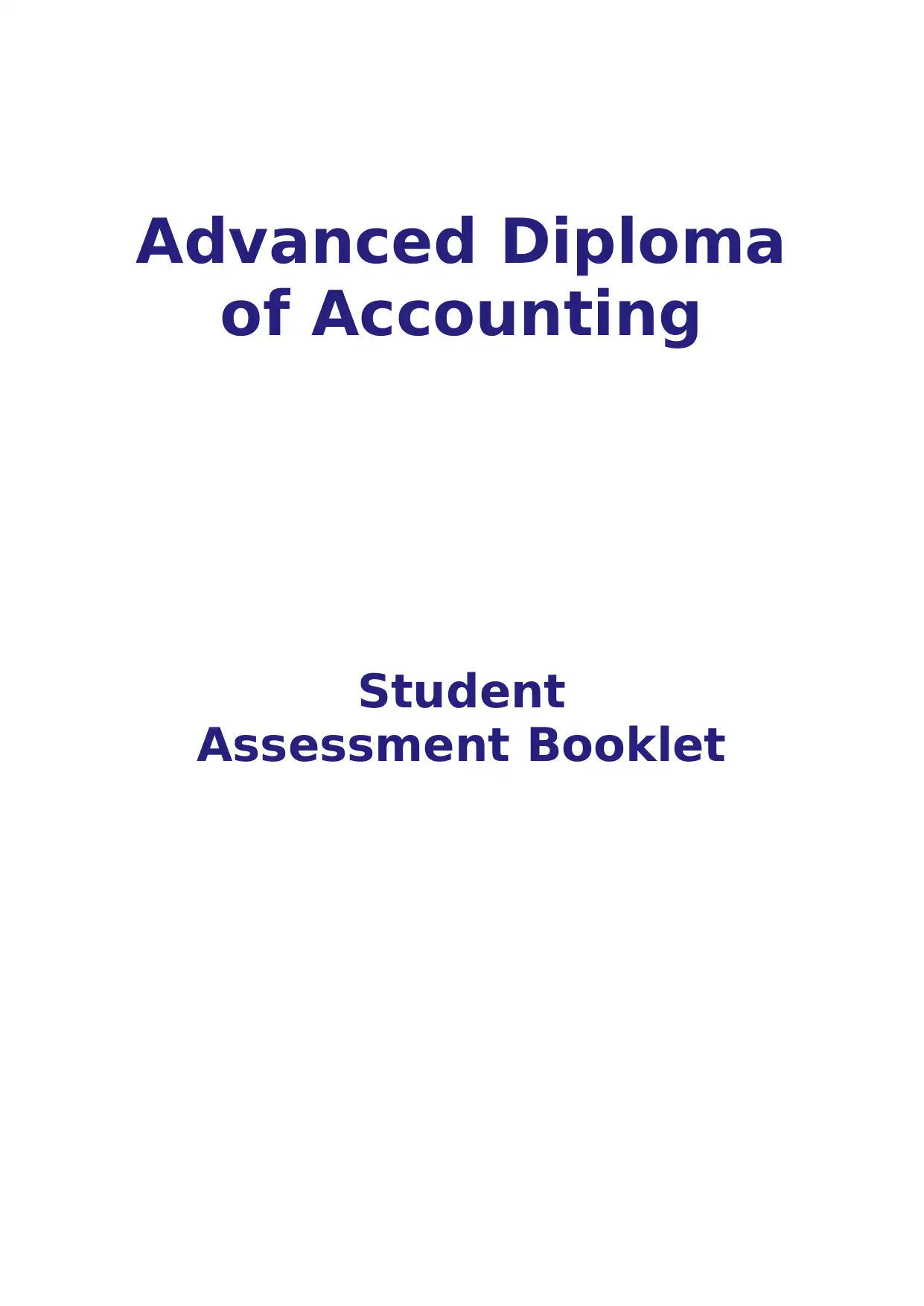
Advanced Diploma
of Accounting
Student
Assessment Booklet
of Accounting
Student
Assessment Booklet
Paraphrase This Document
Need a fresh take? Get an instant paraphrase of this document with our AI Paraphraser
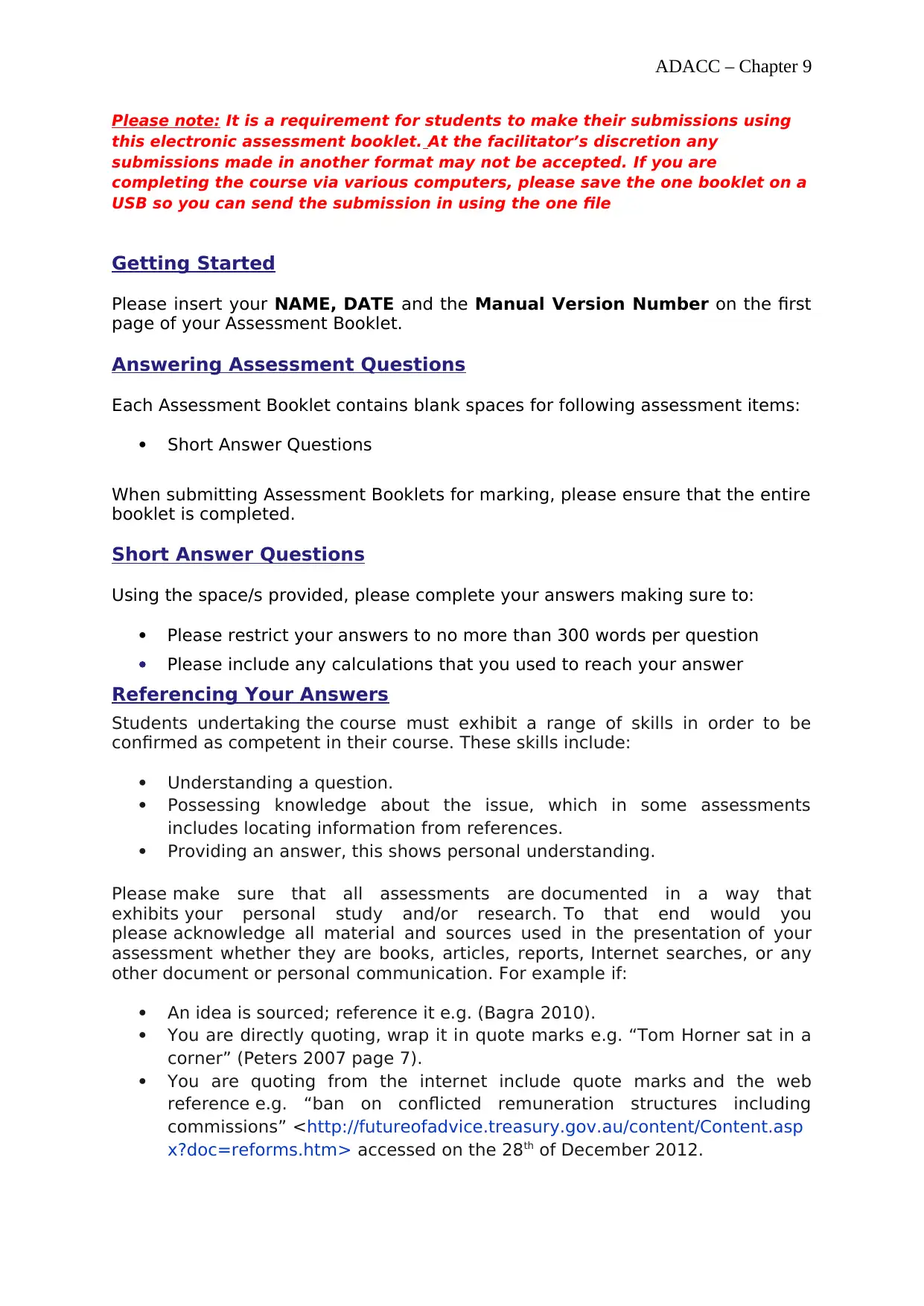
ADACC – Chapter 9
Please note: It is a requirement for students to make their submissions using
this electronic assessment booklet. At the facilitator’s discretion any
submissions made in another format may not be accepted. If you are
completing the course via various computers, please save the one booklet on a
USB so you can send the submission in using the one file
Getting Started
Please insert your NAME, DATE and the Manual Version Number on the first
page of your Assessment Booklet.
Answering Assessment Questions
Each Assessment Booklet contains blank spaces for following assessment items:
Short Answer Questions
When submitting Assessment Booklets for marking, please ensure that the entire
booklet is completed.
Short Answer Questions
Using the space/s provided, please complete your answers making sure to:
Please restrict your answers to no more than 300 words per question
Please include any calculations that you used to reach your answer
Referencing Your Answers
Students undertaking the course must exhibit a range of skills in order to be
confirmed as competent in their course. These skills include:
Understanding a question.
Possessing knowledge about the issue, which in some assessments
includes locating information from references.
Providing an answer, this shows personal understanding.
Please make sure that all assessments are documented in a way that
exhibits your personal study and/or research. To that end would you
please acknowledge all material and sources used in the presentation of your
assessment whether they are books, articles, reports, Internet searches, or any
other document or personal communication. For example if:
An idea is sourced; reference it e.g. (Bagra 2010).
You are directly quoting, wrap it in quote marks e.g. “Tom Horner sat in a
corner” (Peters 2007 page 7).
You are quoting from the internet include quote marks and the web
reference e.g. “ban on conflicted remuneration structures including
commissions” <http://futureofadvice.treasury.gov.au/content/Content.asp
x?doc=reforms.htm> accessed on the 28th of December 2012.
Please note: It is a requirement for students to make their submissions using
this electronic assessment booklet. At the facilitator’s discretion any
submissions made in another format may not be accepted. If you are
completing the course via various computers, please save the one booklet on a
USB so you can send the submission in using the one file
Getting Started
Please insert your NAME, DATE and the Manual Version Number on the first
page of your Assessment Booklet.
Answering Assessment Questions
Each Assessment Booklet contains blank spaces for following assessment items:
Short Answer Questions
When submitting Assessment Booklets for marking, please ensure that the entire
booklet is completed.
Short Answer Questions
Using the space/s provided, please complete your answers making sure to:
Please restrict your answers to no more than 300 words per question
Please include any calculations that you used to reach your answer
Referencing Your Answers
Students undertaking the course must exhibit a range of skills in order to be
confirmed as competent in their course. These skills include:
Understanding a question.
Possessing knowledge about the issue, which in some assessments
includes locating information from references.
Providing an answer, this shows personal understanding.
Please make sure that all assessments are documented in a way that
exhibits your personal study and/or research. To that end would you
please acknowledge all material and sources used in the presentation of your
assessment whether they are books, articles, reports, Internet searches, or any
other document or personal communication. For example if:
An idea is sourced; reference it e.g. (Bagra 2010).
You are directly quoting, wrap it in quote marks e.g. “Tom Horner sat in a
corner” (Peters 2007 page 7).
You are quoting from the internet include quote marks and the web
reference e.g. “ban on conflicted remuneration structures including
commissions” <http://futureofadvice.treasury.gov.au/content/Content.asp
x?doc=reforms.htm> accessed on the 28th of December 2012.
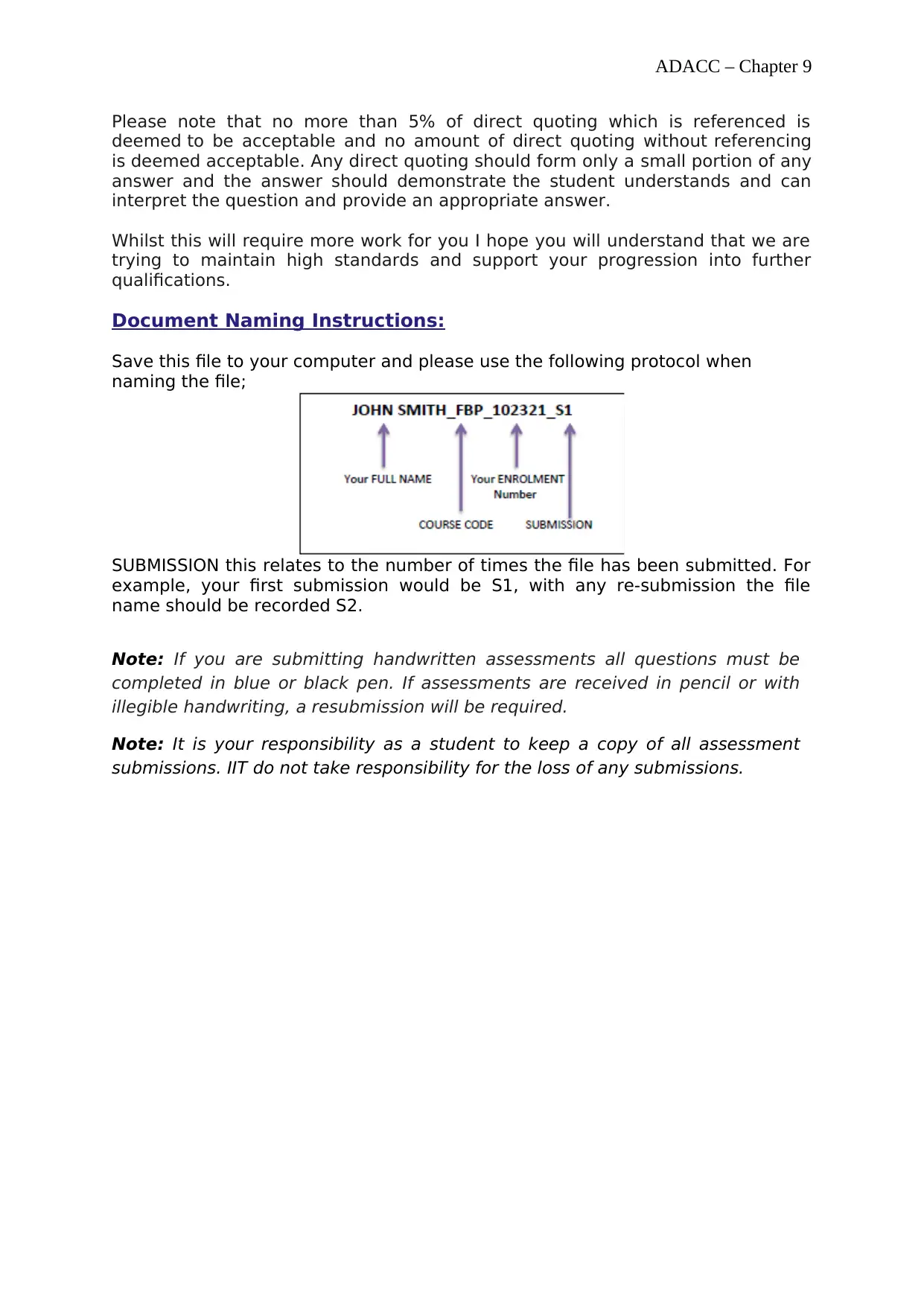
ADACC – Chapter 9
Please note that no more than 5% of direct quoting which is referenced is
deemed to be acceptable and no amount of direct quoting without referencing
is deemed acceptable. Any direct quoting should form only a small portion of any
answer and the answer should demonstrate the student understands and can
interpret the question and provide an appropriate answer.
Whilst this will require more work for you I hope you will understand that we are
trying to maintain high standards and support your progression into further
qualifications.
Document Naming Instructions:
Save this file to your computer and please use the following protocol when
naming the file;
SUBMISSION this relates to the number of times the file has been submitted. For
example, your first submission would be S1, with any re-submission the file
name should be recorded S2.
Note: If you are submitting handwritten assessments all questions must be
completed in blue or black pen. If assessments are received in pencil or with
illegible handwriting, a resubmission will be required.
Note: It is your responsibility as a student to keep a copy of all assessment
submissions. IIT do not take responsibility for the loss of any submissions.
Distance Education Students
Please note that no more than 5% of direct quoting which is referenced is
deemed to be acceptable and no amount of direct quoting without referencing
is deemed acceptable. Any direct quoting should form only a small portion of any
answer and the answer should demonstrate the student understands and can
interpret the question and provide an appropriate answer.
Whilst this will require more work for you I hope you will understand that we are
trying to maintain high standards and support your progression into further
qualifications.
Document Naming Instructions:
Save this file to your computer and please use the following protocol when
naming the file;
SUBMISSION this relates to the number of times the file has been submitted. For
example, your first submission would be S1, with any re-submission the file
name should be recorded S2.
Note: If you are submitting handwritten assessments all questions must be
completed in blue or black pen. If assessments are received in pencil or with
illegible handwriting, a resubmission will be required.
Note: It is your responsibility as a student to keep a copy of all assessment
submissions. IIT do not take responsibility for the loss of any submissions.
Distance Education Students
⊘ This is a preview!⊘
Do you want full access?
Subscribe today to unlock all pages.

Trusted by 1+ million students worldwide
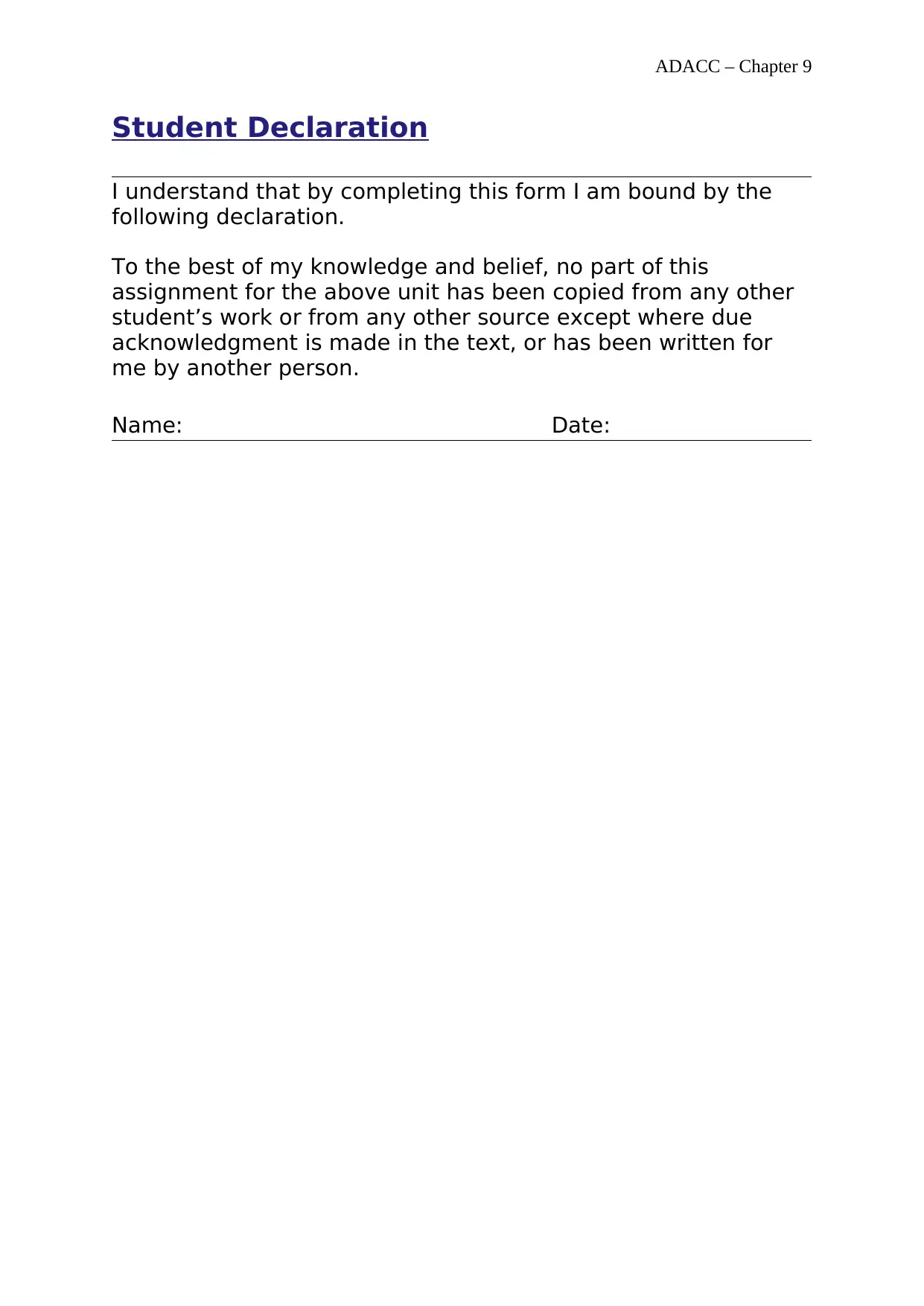
ADACC – Chapter 9
Student Declaration
I understand that by completing this form I am bound by the
following declaration.
To the best of my knowledge and belief, no part of this
assignment for the above unit has been copied from any other
student’s work or from any other source except where due
acknowledgment is made in the text, or has been written for
me by another person.
Name: Date:
Student Declaration
I understand that by completing this form I am bound by the
following declaration.
To the best of my knowledge and belief, no part of this
assignment for the above unit has been copied from any other
student’s work or from any other source except where due
acknowledgment is made in the text, or has been written for
me by another person.
Name: Date:
Paraphrase This Document
Need a fresh take? Get an instant paraphrase of this document with our AI Paraphraser
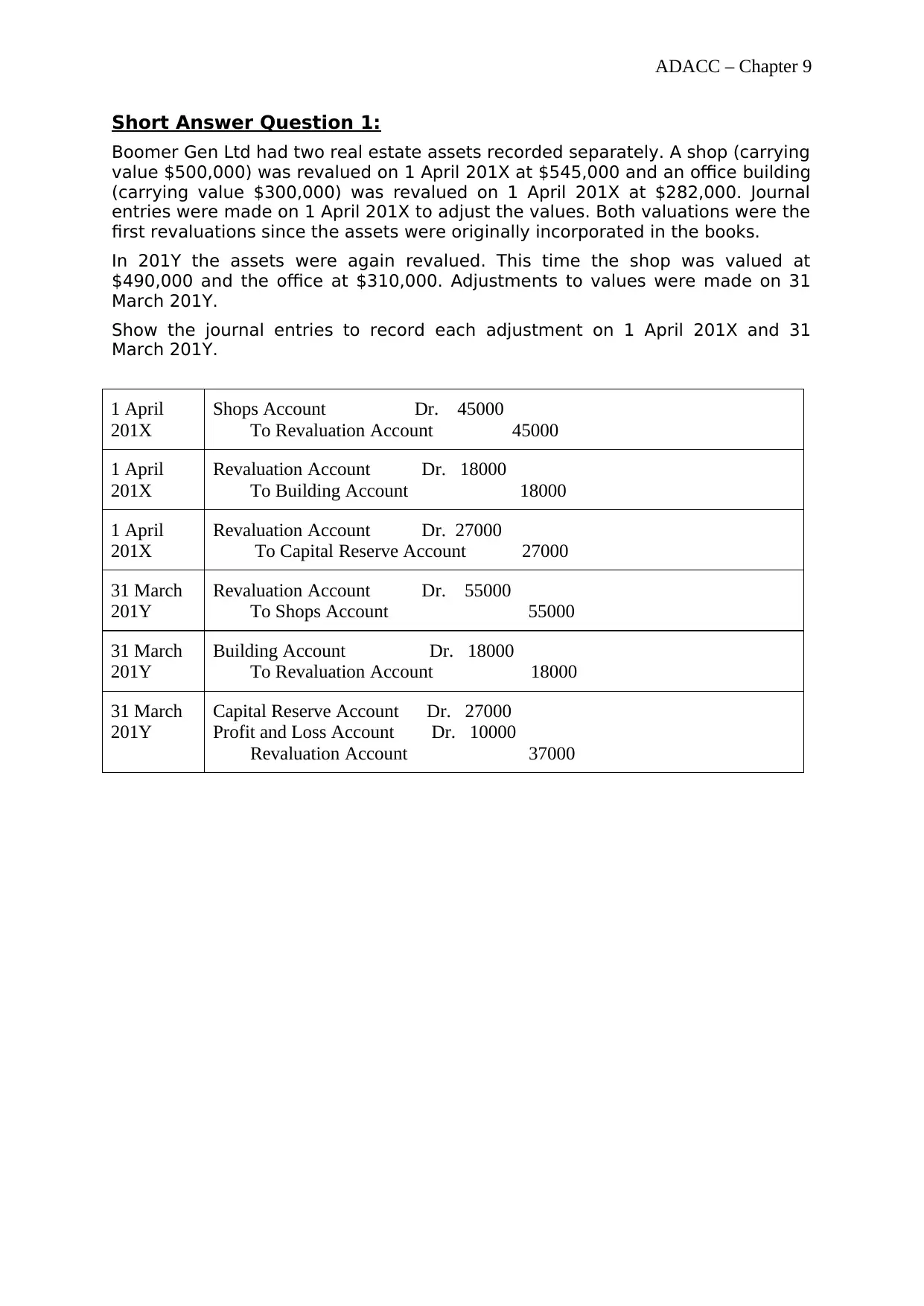
ADACC – Chapter 9
Short Answer Question 1:
Boomer Gen Ltd had two real estate assets recorded separately. A shop (carrying
value $500,000) was revalued on 1 April 201X at $545,000 and an office building
(carrying value $300,000) was revalued on 1 April 201X at $282,000. Journal
entries were made on 1 April 201X to adjust the values. Both valuations were the
first revaluations since the assets were originally incorporated in the books.
In 201Y the assets were again revalued. This time the shop was valued at
$490,000 and the office at $310,000. Adjustments to values were made on 31
March 201Y.
Show the journal entries to record each adjustment on 1 April 201X and 31
March 201Y.
1 April
201X
Shops Account Dr. 45000
To Revaluation Account 45000
1 April
201X
Revaluation Account Dr. 18000
To Building Account 18000
1 April
201X
Revaluation Account Dr. 27000
To Capital Reserve Account 27000
31 March
201Y
Revaluation Account Dr. 55000
To Shops Account 55000
31 March
201Y
Building Account Dr. 18000
To Revaluation Account 18000
31 March
201Y
Capital Reserve Account Dr. 27000
Profit and Loss Account Dr. 10000
Revaluation Account 37000
Short Answer Question 1:
Boomer Gen Ltd had two real estate assets recorded separately. A shop (carrying
value $500,000) was revalued on 1 April 201X at $545,000 and an office building
(carrying value $300,000) was revalued on 1 April 201X at $282,000. Journal
entries were made on 1 April 201X to adjust the values. Both valuations were the
first revaluations since the assets were originally incorporated in the books.
In 201Y the assets were again revalued. This time the shop was valued at
$490,000 and the office at $310,000. Adjustments to values were made on 31
March 201Y.
Show the journal entries to record each adjustment on 1 April 201X and 31
March 201Y.
1 April
201X
Shops Account Dr. 45000
To Revaluation Account 45000
1 April
201X
Revaluation Account Dr. 18000
To Building Account 18000
1 April
201X
Revaluation Account Dr. 27000
To Capital Reserve Account 27000
31 March
201Y
Revaluation Account Dr. 55000
To Shops Account 55000
31 March
201Y
Building Account Dr. 18000
To Revaluation Account 18000
31 March
201Y
Capital Reserve Account Dr. 27000
Profit and Loss Account Dr. 10000
Revaluation Account 37000
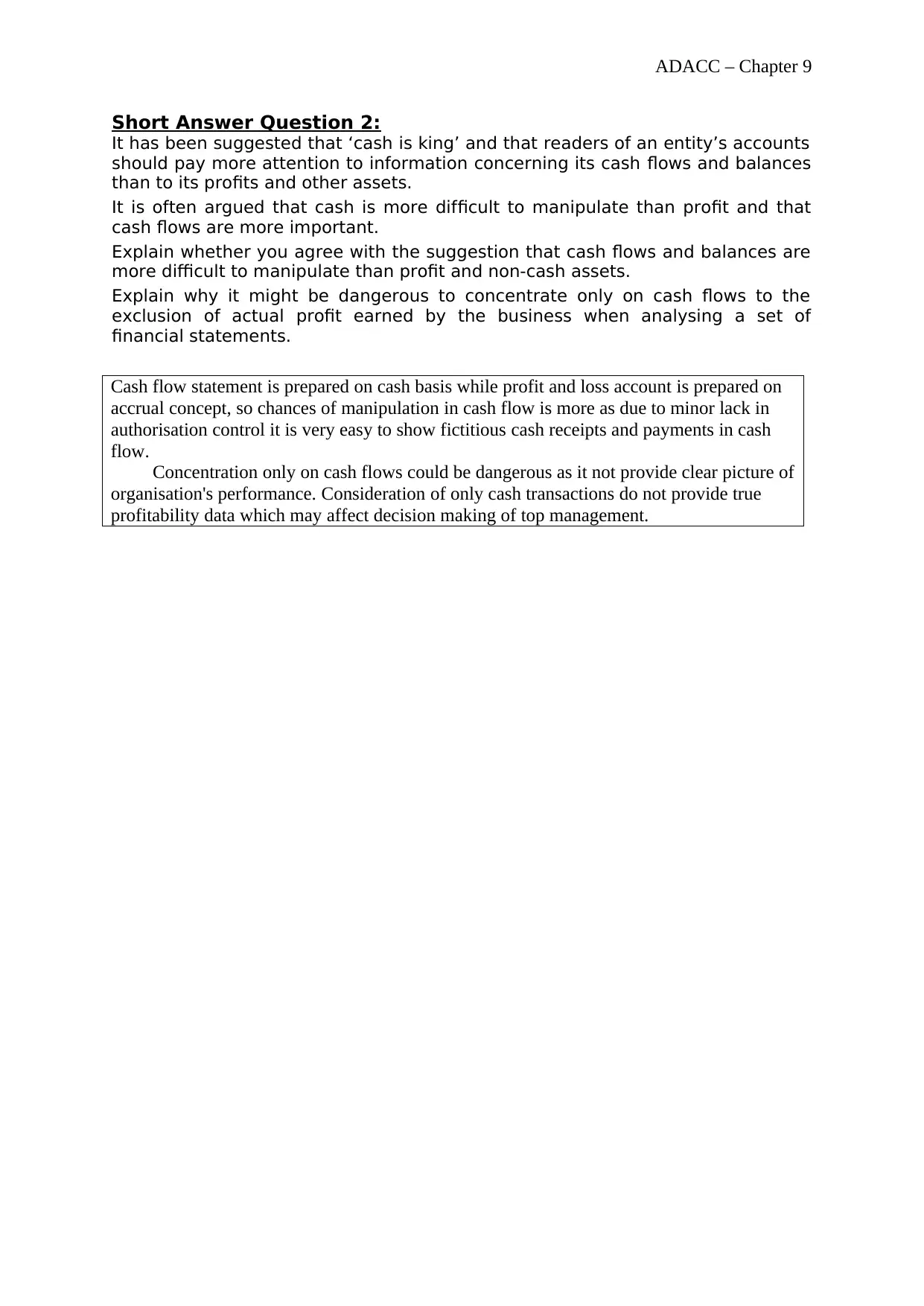
ADACC – Chapter 9
Short Answer Question 2:
It has been suggested that ‘cash is king’ and that readers of an entity’s accounts
should pay more attention to information concerning its cash flows and balances
than to its profits and other assets.
It is often argued that cash is more difficult to manipulate than profit and that
cash flows are more important.
Explain whether you agree with the suggestion that cash flows and balances are
more difficult to manipulate than profit and non-cash assets.
Explain why it might be dangerous to concentrate only on cash flows to the
exclusion of actual profit earned by the business when analysing a set of
financial statements.
Cash flow statement is prepared on cash basis while profit and loss account is prepared on
accrual concept, so chances of manipulation in cash flow is more as due to minor lack in
authorisation control it is very easy to show fictitious cash receipts and payments in cash
flow.
Concentration only on cash flows could be dangerous as it not provide clear picture of
organisation's performance. Consideration of only cash transactions do not provide true
profitability data which may affect decision making of top management.
Short Answer Question 2:
It has been suggested that ‘cash is king’ and that readers of an entity’s accounts
should pay more attention to information concerning its cash flows and balances
than to its profits and other assets.
It is often argued that cash is more difficult to manipulate than profit and that
cash flows are more important.
Explain whether you agree with the suggestion that cash flows and balances are
more difficult to manipulate than profit and non-cash assets.
Explain why it might be dangerous to concentrate only on cash flows to the
exclusion of actual profit earned by the business when analysing a set of
financial statements.
Cash flow statement is prepared on cash basis while profit and loss account is prepared on
accrual concept, so chances of manipulation in cash flow is more as due to minor lack in
authorisation control it is very easy to show fictitious cash receipts and payments in cash
flow.
Concentration only on cash flows could be dangerous as it not provide clear picture of
organisation's performance. Consideration of only cash transactions do not provide true
profitability data which may affect decision making of top management.
⊘ This is a preview!⊘
Do you want full access?
Subscribe today to unlock all pages.

Trusted by 1+ million students worldwide
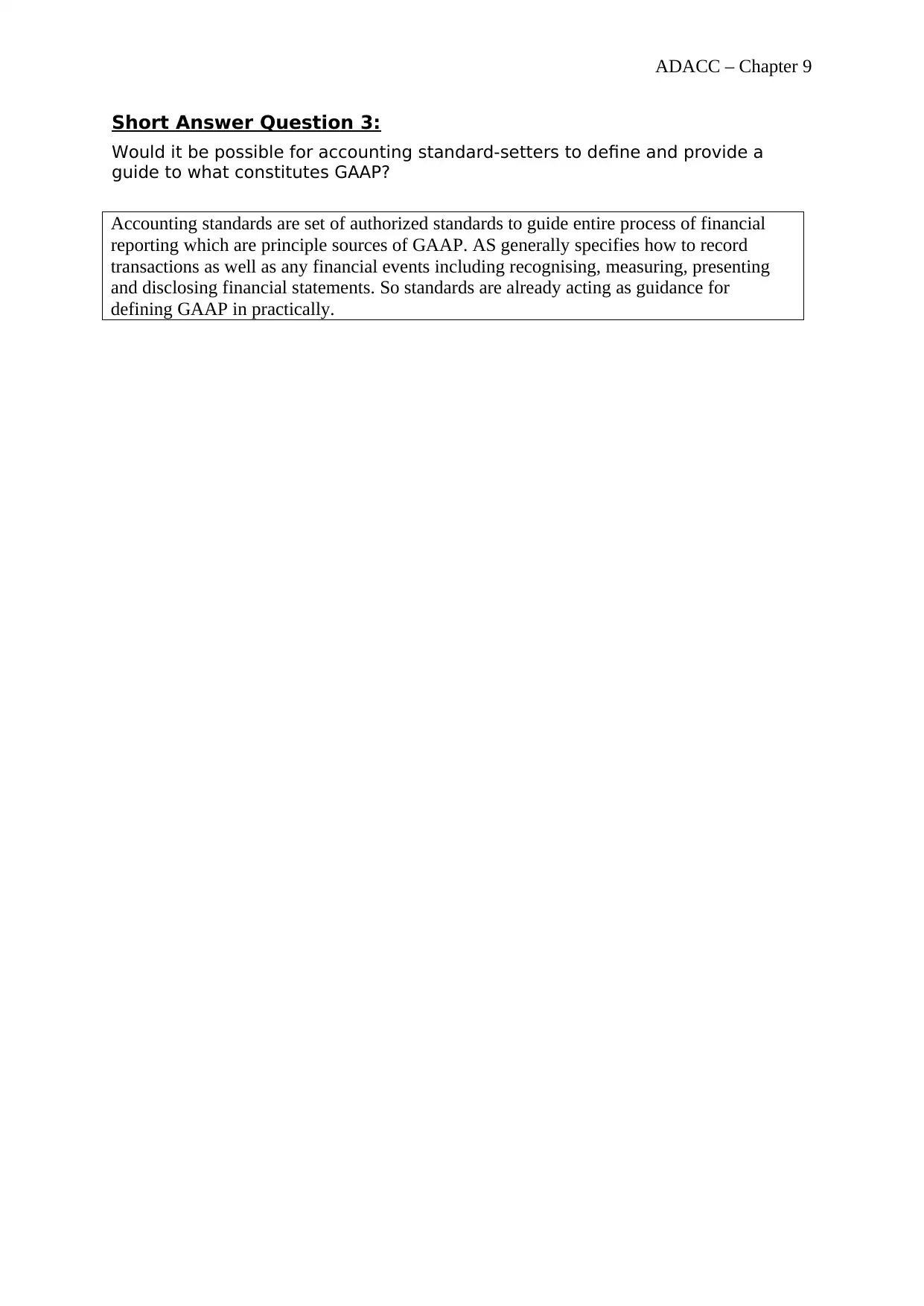
ADACC – Chapter 9
Short Answer Question 3:
Would it be possible for accounting standard-setters to define and provide a
guide to what constitutes GAAP?
Accounting standards are set of authorized standards to guide entire process of financial
reporting which are principle sources of GAAP. AS generally specifies how to record
transactions as well as any financial events including recognising, measuring, presenting
and disclosing financial statements. So standards are already acting as guidance for
defining GAAP in practically.
Short Answer Question 3:
Would it be possible for accounting standard-setters to define and provide a
guide to what constitutes GAAP?
Accounting standards are set of authorized standards to guide entire process of financial
reporting which are principle sources of GAAP. AS generally specifies how to record
transactions as well as any financial events including recognising, measuring, presenting
and disclosing financial statements. So standards are already acting as guidance for
defining GAAP in practically.
Paraphrase This Document
Need a fresh take? Get an instant paraphrase of this document with our AI Paraphraser
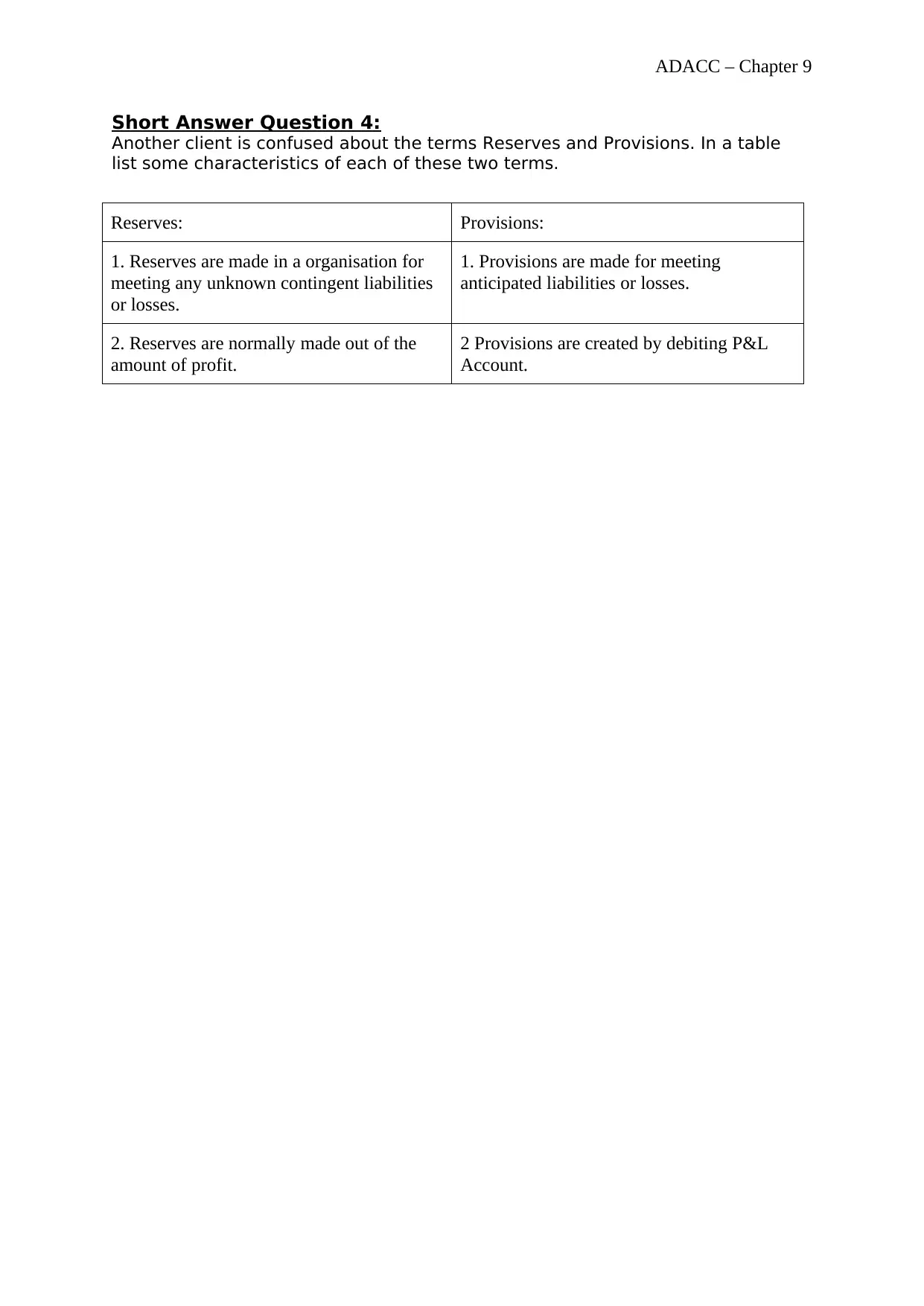
ADACC – Chapter 9
Short Answer Question 4:
Another client is confused about the terms Reserves and Provisions. In a table
list some characteristics of each of these two terms.
Reserves: Provisions:
1. Reserves are made in a organisation for
meeting any unknown contingent liabilities
or losses.
1. Provisions are made for meeting
anticipated liabilities or losses.
2. Reserves are normally made out of the
amount of profit.
2 Provisions are created by debiting P&L
Account.
Short Answer Question 4:
Another client is confused about the terms Reserves and Provisions. In a table
list some characteristics of each of these two terms.
Reserves: Provisions:
1. Reserves are made in a organisation for
meeting any unknown contingent liabilities
or losses.
1. Provisions are made for meeting
anticipated liabilities or losses.
2. Reserves are normally made out of the
amount of profit.
2 Provisions are created by debiting P&L
Account.
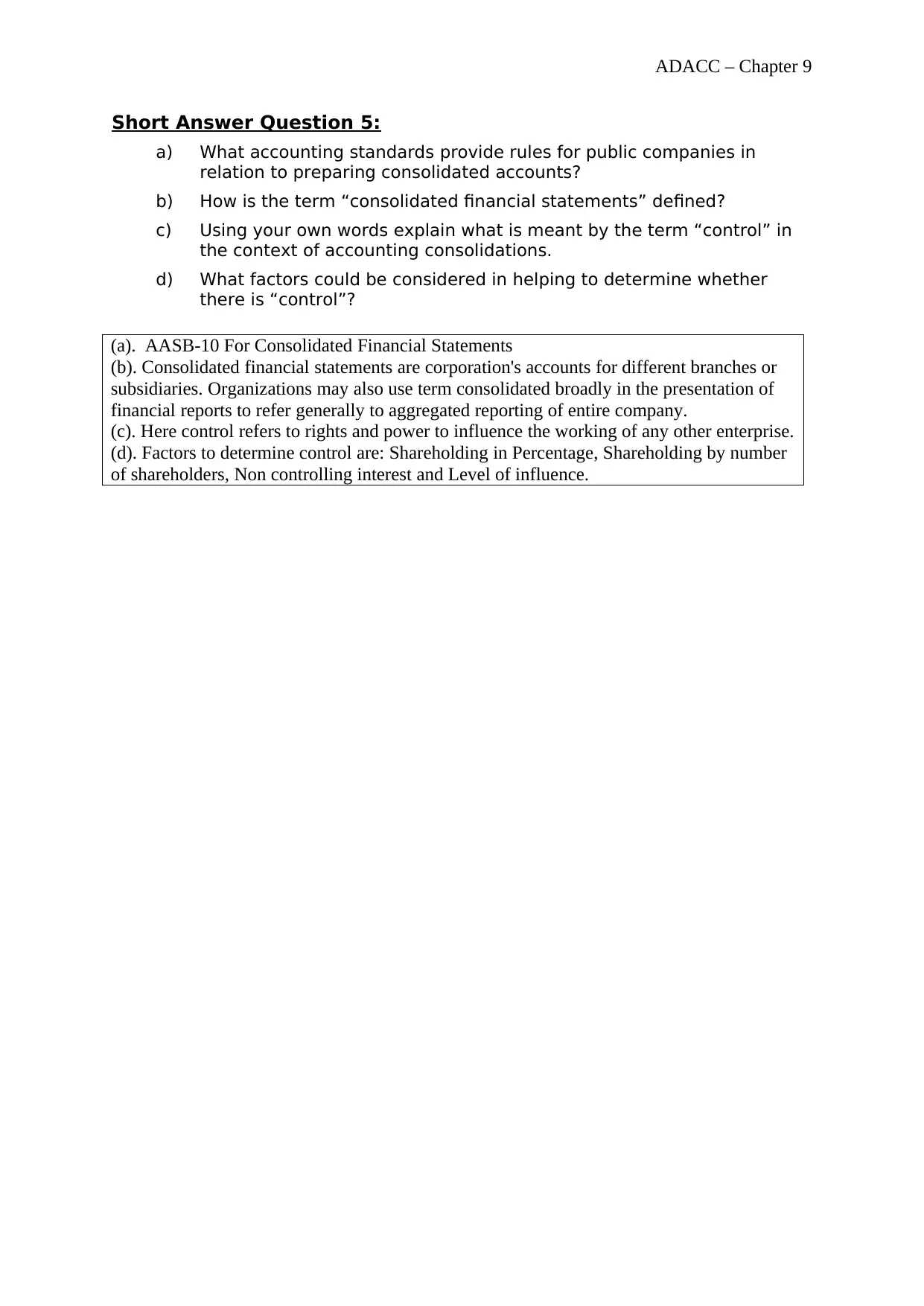
ADACC – Chapter 9
Short Answer Question 5:
a) What accounting standards provide rules for public companies in
relation to preparing consolidated accounts?
b) How is the term “consolidated financial statements” defined?
c) Using your own words explain what is meant by the term “control” in
the context of accounting consolidations.
d) What factors could be considered in helping to determine whether
there is “control”?
(a). AASB-10 For Consolidated Financial Statements
(b). Consolidated financial statements are corporation's accounts for different branches or
subsidiaries. Organizations may also use term consolidated broadly in the presentation of
financial reports to refer generally to aggregated reporting of entire company.
(c). Here control refers to rights and power to influence the working of any other enterprise.
(d). Factors to determine control are: Shareholding in Percentage, Shareholding by number
of shareholders, Non controlling interest and Level of influence.
Short Answer Question 5:
a) What accounting standards provide rules for public companies in
relation to preparing consolidated accounts?
b) How is the term “consolidated financial statements” defined?
c) Using your own words explain what is meant by the term “control” in
the context of accounting consolidations.
d) What factors could be considered in helping to determine whether
there is “control”?
(a). AASB-10 For Consolidated Financial Statements
(b). Consolidated financial statements are corporation's accounts for different branches or
subsidiaries. Organizations may also use term consolidated broadly in the presentation of
financial reports to refer generally to aggregated reporting of entire company.
(c). Here control refers to rights and power to influence the working of any other enterprise.
(d). Factors to determine control are: Shareholding in Percentage, Shareholding by number
of shareholders, Non controlling interest and Level of influence.
⊘ This is a preview!⊘
Do you want full access?
Subscribe today to unlock all pages.

Trusted by 1+ million students worldwide
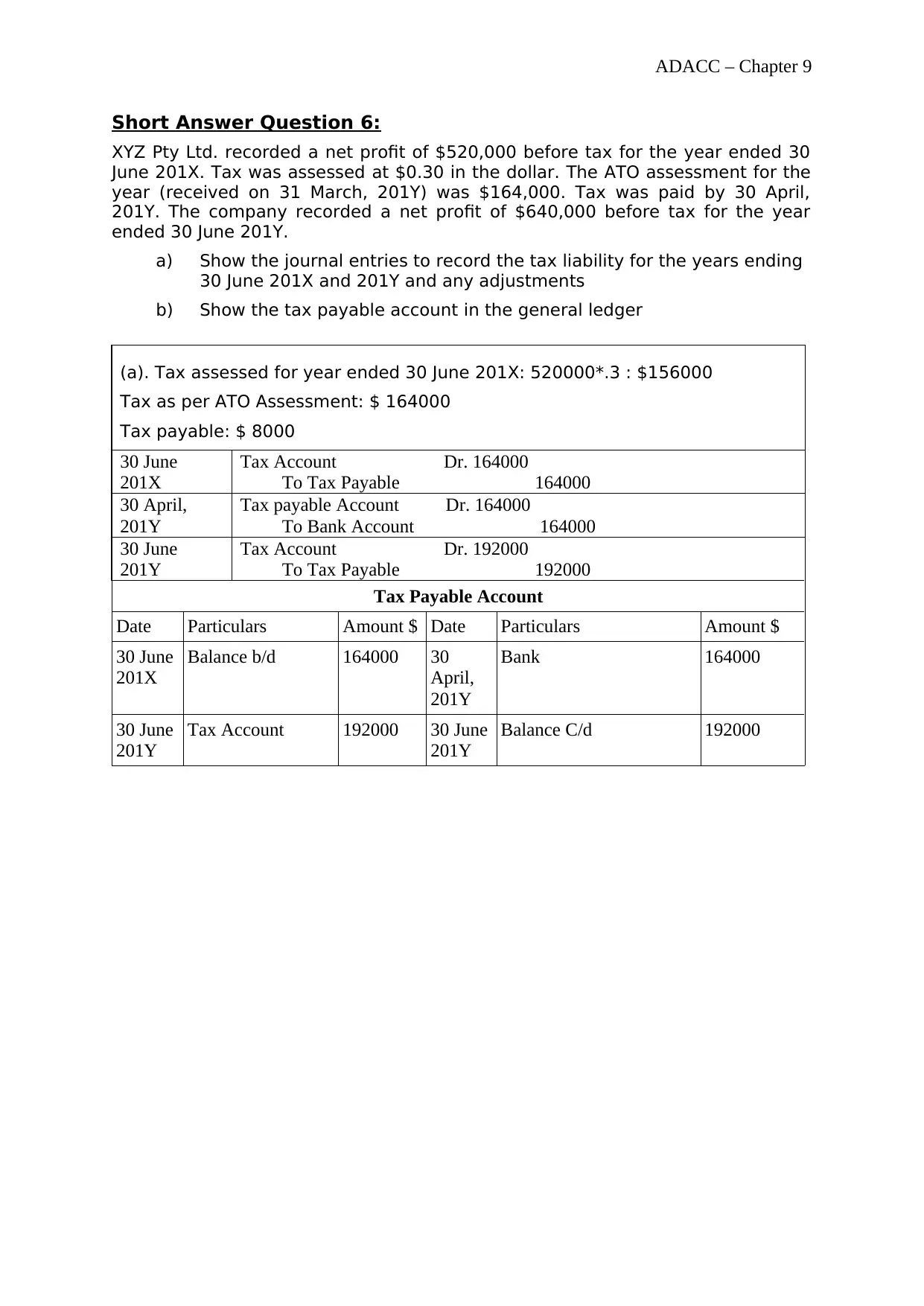
ADACC – Chapter 9
Short Answer Question 6:
XYZ Pty Ltd. recorded a net profit of $520,000 before tax for the year ended 30
June 201X. Tax was assessed at $0.30 in the dollar. The ATO assessment for the
year (received on 31 March, 201Y) was $164,000. Tax was paid by 30 April,
201Y. The company recorded a net profit of $640,000 before tax for the year
ended 30 June 201Y.
a) Show the journal entries to record the tax liability for the years ending
30 June 201X and 201Y and any adjustments
b) Show the tax payable account in the general ledger
(a). Tax assessed for year ended 30 June 201X: 520000*.3 : $156000
Tax as per ATO Assessment: $ 164000
Tax payable: $ 8000
30 June
201X
Tax Account Dr. 164000
To Tax Payable 164000
30 April,
201Y
Tax payable Account Dr. 164000
To Bank Account 164000
30 June
201Y
Tax Account Dr. 192000
To Tax Payable 192000
Tax Payable Account
Date Particulars Amount $ Date Particulars Amount $
30 June
201X
Balance b/d 164000 30
April,
201Y
Bank 164000
30 June
201Y
Tax Account 192000 30 June
201Y
Balance C/d 192000
Short Answer Question 6:
XYZ Pty Ltd. recorded a net profit of $520,000 before tax for the year ended 30
June 201X. Tax was assessed at $0.30 in the dollar. The ATO assessment for the
year (received on 31 March, 201Y) was $164,000. Tax was paid by 30 April,
201Y. The company recorded a net profit of $640,000 before tax for the year
ended 30 June 201Y.
a) Show the journal entries to record the tax liability for the years ending
30 June 201X and 201Y and any adjustments
b) Show the tax payable account in the general ledger
(a). Tax assessed for year ended 30 June 201X: 520000*.3 : $156000
Tax as per ATO Assessment: $ 164000
Tax payable: $ 8000
30 June
201X
Tax Account Dr. 164000
To Tax Payable 164000
30 April,
201Y
Tax payable Account Dr. 164000
To Bank Account 164000
30 June
201Y
Tax Account Dr. 192000
To Tax Payable 192000
Tax Payable Account
Date Particulars Amount $ Date Particulars Amount $
30 June
201X
Balance b/d 164000 30
April,
201Y
Bank 164000
30 June
201Y
Tax Account 192000 30 June
201Y
Balance C/d 192000
Paraphrase This Document
Need a fresh take? Get an instant paraphrase of this document with our AI Paraphraser
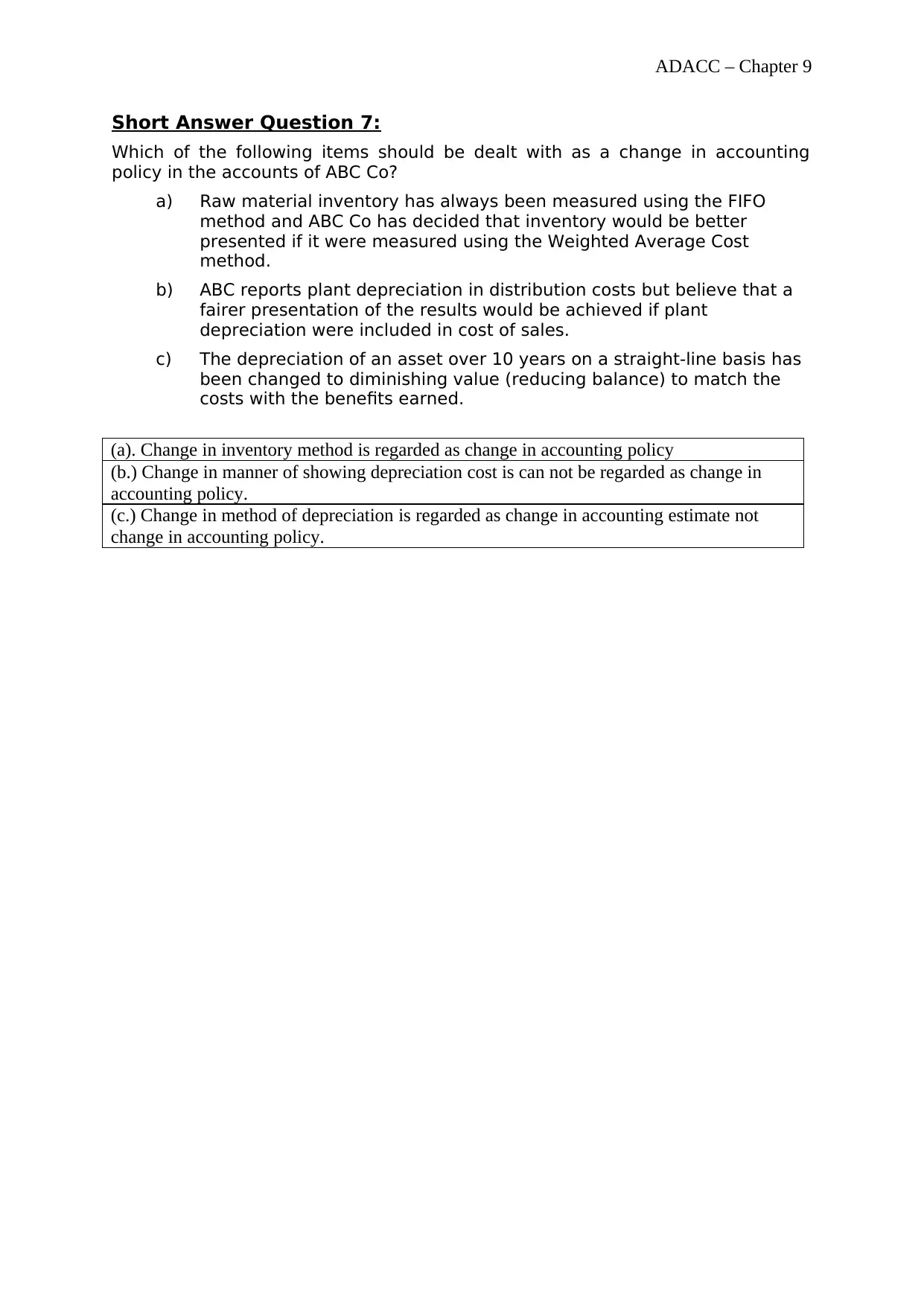
ADACC – Chapter 9
Short Answer Question 7:
Which of the following items should be dealt with as a change in accounting
policy in the accounts of ABC Co?
a) Raw material inventory has always been measured using the FIFO
method and ABC Co has decided that inventory would be better
presented if it were measured using the Weighted Average Cost
method.
b) ABC reports plant depreciation in distribution costs but believe that a
fairer presentation of the results would be achieved if plant
depreciation were included in cost of sales.
c) The depreciation of an asset over 10 years on a straight-line basis has
been changed to diminishing value (reducing balance) to match the
costs with the benefits earned.
(a). Change in inventory method is regarded as change in accounting policy
(b.) Change in manner of showing depreciation cost is can not be regarded as change in
accounting policy.
(c.) Change in method of depreciation is regarded as change in accounting estimate not
change in accounting policy.
Short Answer Question 7:
Which of the following items should be dealt with as a change in accounting
policy in the accounts of ABC Co?
a) Raw material inventory has always been measured using the FIFO
method and ABC Co has decided that inventory would be better
presented if it were measured using the Weighted Average Cost
method.
b) ABC reports plant depreciation in distribution costs but believe that a
fairer presentation of the results would be achieved if plant
depreciation were included in cost of sales.
c) The depreciation of an asset over 10 years on a straight-line basis has
been changed to diminishing value (reducing balance) to match the
costs with the benefits earned.
(a). Change in inventory method is regarded as change in accounting policy
(b.) Change in manner of showing depreciation cost is can not be regarded as change in
accounting policy.
(c.) Change in method of depreciation is regarded as change in accounting estimate not
change in accounting policy.
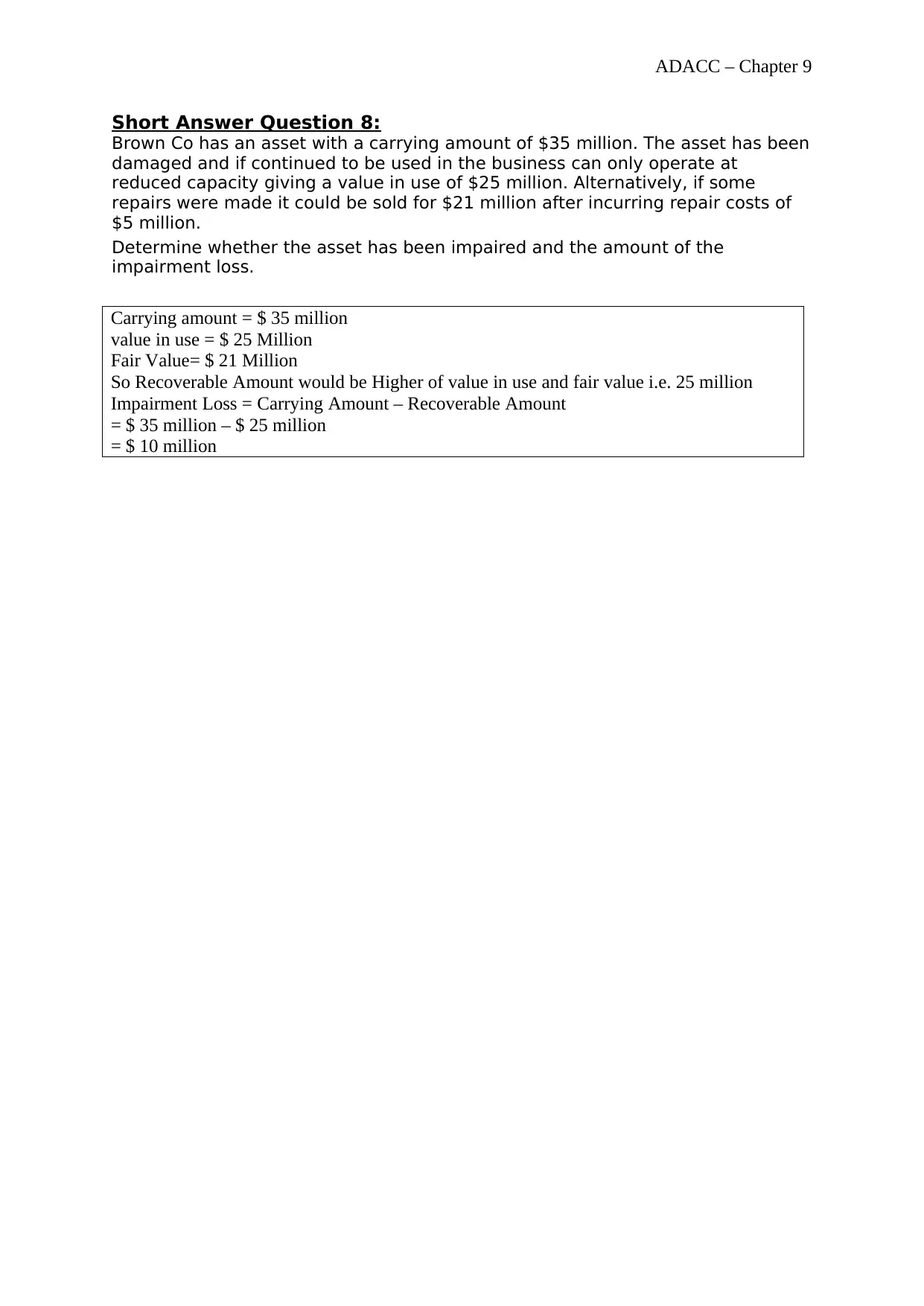
ADACC – Chapter 9
Short Answer Question 8:
Brown Co has an asset with a carrying amount of $35 million. The asset has been
damaged and if continued to be used in the business can only operate at
reduced capacity giving a value in use of $25 million. Alternatively, if some
repairs were made it could be sold for $21 million after incurring repair costs of
$5 million.
Determine whether the asset has been impaired and the amount of the
impairment loss.
Carrying amount = $ 35 million
value in use = $ 25 Million
Fair Value= $ 21 Million
So Recoverable Amount would be Higher of value in use and fair value i.e. 25 million
Impairment Loss = Carrying Amount – Recoverable Amount
= $ 35 million – $ 25 million
= $ 10 million
Short Answer Question 8:
Brown Co has an asset with a carrying amount of $35 million. The asset has been
damaged and if continued to be used in the business can only operate at
reduced capacity giving a value in use of $25 million. Alternatively, if some
repairs were made it could be sold for $21 million after incurring repair costs of
$5 million.
Determine whether the asset has been impaired and the amount of the
impairment loss.
Carrying amount = $ 35 million
value in use = $ 25 Million
Fair Value= $ 21 Million
So Recoverable Amount would be Higher of value in use and fair value i.e. 25 million
Impairment Loss = Carrying Amount – Recoverable Amount
= $ 35 million – $ 25 million
= $ 10 million
⊘ This is a preview!⊘
Do you want full access?
Subscribe today to unlock all pages.

Trusted by 1+ million students worldwide
1 out of 23
Related Documents
Your All-in-One AI-Powered Toolkit for Academic Success.
+13062052269
info@desklib.com
Available 24*7 on WhatsApp / Email
![[object Object]](/_next/static/media/star-bottom.7253800d.svg)
Unlock your academic potential
Copyright © 2020–2025 A2Z Services. All Rights Reserved. Developed and managed by ZUCOL.





